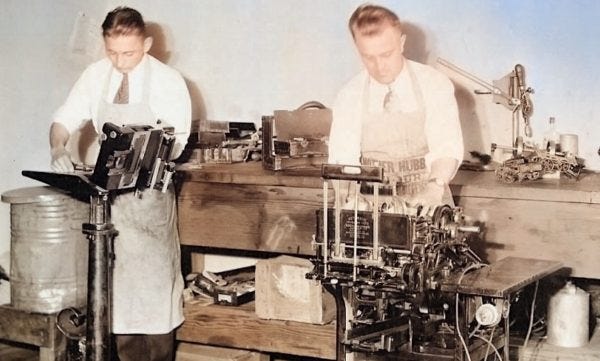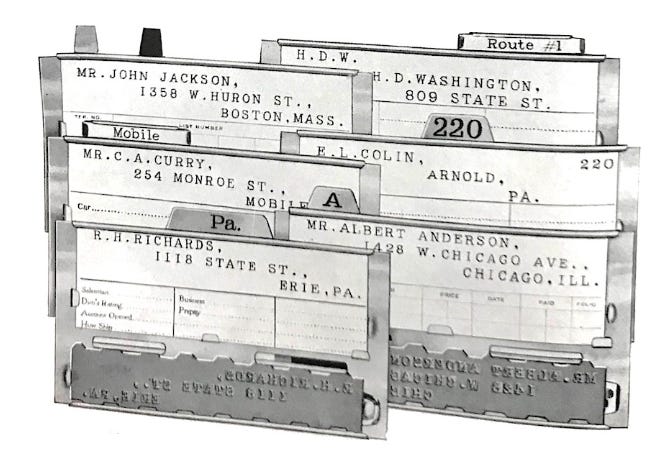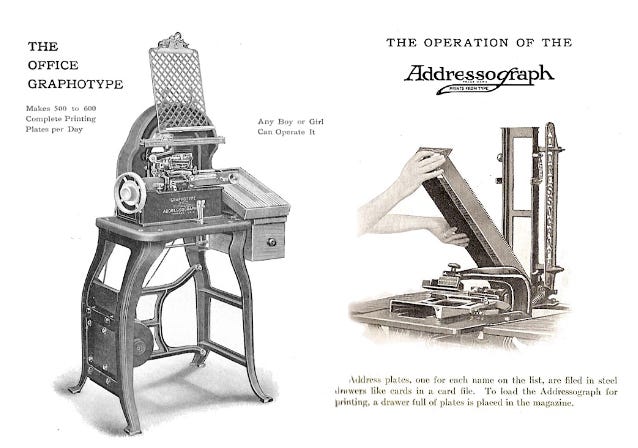Val Ross is back with another great look at her time in Scientology and the bizarre ways of the Sea Org.
Looking back on my days in Scientology it’s the little details, negligible to me at the time, that make me realize just how controlled the group was in every aspect of our lives.
Take, for example the Addressograph, more commonly called the Addresso by Sea Org members. Although the telex machine is the butt of jokes when talking about Scientology, the Addresso was another archaic piece of equipment that was ordered to be used by Hubbard in all orgs.
The Addressograph was a big deal when it first came out in the 1890s. By the time Xerox invented new technology, Addressograph was struggling with its outdated technology, but in the late 1970s, Hubbard still demanded that it be used.
It was a fairly large machine. The way it operated was by feeding steel plates from an attached tray into the machine one by one, which would stamp the name and address on the letter or envelope. This was a sort of primitive mail merge. The drawers you see that look like library card files are actually Addresso trays, each one full of cards with names and addresses stamped on them.
Each tray was loaded on to the machine individually, and the machine would go through the whole tray. The operator of the machine sat there and pressed the foot pedal to stamp the addresses on the document. The cards would advance each time the operator hit the pedal. The operator also had to ensure there were no jams, the paper or envelopes were loaded and then change out the tray when it reached the end.
This became cumbersome quickly because the cards were always kept in alphabetical order. The tray held 275 cards. There were always one or two full time staff members assigned to central files. This was never enough.
If someone changed their address, a new card had to be made and the old one pulled. If a new person bought a book or even filled out a survey, their name was added to Central Files. This entailed putting their name in order in the correct Addresso tray, removing the last card of that tray and putting it at the start of the next tray, etc. If they got 15 new names a day, they had to do this 15 times a day, all the while keeping up with the continuous mailings and the mass flow of paper to be filed.
Central Files received a constant influx of paper hourly. There was a person in the Org whose job it was to take paper to CF. A copy of every letter written, every receipt written were all routed to Central Files. And they all had to be put in the person’s individual file for financial planning, correspondence, etc. and new files had to be created if they didn’t exist.
Considering what the one or two people in Central Files were faced with every day, it’s no surprise they didn’t keep up. Running the Addresso was a full time job, even without problems. And, like all other Sea Org posts, it was just assumed that the person had done that job some other lifetime so little or no training was ever given. Some of the people assigned to CF had no knowledge on something as simple as alphabetizing.
When new names came into CF, a common shortcut would be to create a new Addresso tray with the new names rather than integrating the new ones into the old trays. And no, names were never ever taken out. It was against policy. It was a high crime to remove someone from the mailing list.
After about a month of running ragged in Central Files, the one or two staff members currently posted there would have a surprise inspection by the Commanding Officer. In our case, that was Irene Howey. And, of course, Central Files would be a mess. At least one person would be busted and an all hands muster would be called.
This meant that every staff member, no matter what their post, was required to attend. At ASHO on Temple Street, there was a large unshaded concrete area with no tables, chairs or grass behind the building ironically called the patio. This was where our musters were held.
During the all hands, which usually occurred on Fridays, we stood at attention while our CO ranted on about the horrible state of affairs of CF then we were told to get dinner and be back for an all-nighter in half an hour. We would race off, eat, then come right back.
Roll would be called, if someone was not there, others were deputized to hunt them down. And the long night would begin. We were all still in our day wear, whatever we had worn during the day, some in uniforms, some in their public-facing nice street clothes, which we were required to purchase for ourselves.
We were not given the time to go back to berthing and change clothes. Nor were we given anywhere to sit while we began our work. We would venture into the depths of Central Files and begin hauling out whatever we were supposed to work on. Others were required to stand for hours putting pieces of paper in files.
I was always assigned Addresso sort because in my younger days I had spent a lot of time at our town’s local newspaper and knew how to set type by hand, so that translated to me being able to alphabetize and sort things in a freakishly fast manner. If you consider that ASHO was an advanced org, my guess at the time is that there were over 40,000 names on those cards. I don’t know how many were people who had done more than taken a personality test or bought a book, but there were at least 150 Addresso trays.
I would sit there on the cold concrete all night long, starting with the A drawer and pull and re-sort, collating from the two or three extra drawers of new names that had been added. By 8 am, with people running back and forth all night, we generally had the Addresso back up to date in time to eat breakfast.
Not only were we not given chairs to sit on or tables to work at, we were not even given water, or any other refreshments while we pulled these all-nighters. I do not remember ever thinking at the time that there was anything wrong with this. However, about the third month in a row that we had to pull an all-nighter in order to get Central Files back in order, I do recall thinking that someone needed to rethink how CF was staffed because they really needed more help down there.
I don’t know when they switched from using the Addresso, or if it made anyone’s life easier when they did. That is something I see clearly now. Most of the things that were done were about making our lives harder. We were being subtly trained to enjoy pain.
— Valerie Ross
Want to help?
Please consider joining the Underground Bunker as a paid subscriber. Your $7 a month will go a long way to helping this news project stay independent, and you’ll get access to our special material for subscribers. Or, you can support the Underground Bunker with a Paypal contribution to bunkerfund@tonyortega.org, an account administered by the Bunker’s attorney, Scott Pilutik. And by request, this is our Venmo link, and for Zelle, please use (tonyo94 AT gmail). E-mail tips to tonyo94@gmail.com.
Thank you for reading today’s story here at Substack. For the full picture of what’s happening today in the world of Scientology, please join the conversation at tonyortega.org, where we’ve been reporting daily on David Miscavige’s cabal since 2012. There you’ll find additional stories, and our popular regular daily features:
Source Code: Actual things founder L. Ron Hubbard said on this date in history
Avast, Ye Mateys: Snapshots from Scientology’s years at sea
Overheard in the Freezone: Indie Hubbardism, one thought at a time
Past is Prologue: From this week in history at alt.religion.scientology
Random Howdy: Your daily dose of the Captain
Here’s the link to today’s post at tonyortega.org
And whatever you do, subscribe to this Substack so you get our breaking stories and daily features right to your email inbox every morning.
Paid subscribers get access to a special podcast series…
Group Therapy: Our round table of rowdy regulars on the week’s news






So true, Val. If there is an easy simple modern way to do something the Sea Org will go for the ancient, labor-intensive horrific option.
How many serfs does it take to screw in a light bulb? Dunno, no light bulbs in the castle dude. Takes an army of serfs to place and light the rushes every night though.
Behind the big LRH House at the Int Base you can see a row of smaller buildings. The one on the far left is a small theatre with 35 mm dual projectors. Some of the others are guest houses, mostly for Tom Cruise and his entourage.
One of them is a museum of Hubbard artifacts. Hundreds of cameras, every kind of old E-Meter including the Japanese toy meter and the old Mathison Beep meter. Ancient 50s and 60s audio gear, like the old Neve mix board. You can sometimes see pictures of this in the Ron Magazine issues.
That Hubbard, such a collector! He had old junk that he never even looked at, all stacked up around him like Scrooge McDuck. They even kept the boxes and packaging for all his acquisitions, stacked up in attics like the Music Studio attic. And the famous Del Sol attic.
There were I think 10 or 15 staff completely devoted to Hubbard purchasing, called Logistics. The order would come down to buy something, the crew would leap into action. Sparing no sleep time or money until the item was delivered as ordered. Woe unto the Logistics operator that delivered a Nikon F2AS when an F2A was requested!
I guess it gave a boost to his endless ego whenever a new acquisition or hapless slave was added to his collection. It seemed to give him no particular pleasure to actually use them for a good purpose though. He would never relinquish a possession but trashed his staff at will. As the Bible says, where a man's treasure is there also his heart is. Matthew 6:20,21.
"We were being subtly trained to enjoy pain." Wow, just freakin wow. Staff and Sea Org really were the flagellates of $cientology.
No doubt that by now the mailing list is being done electronically and mail merge is being used. I mean, how can anyone in this time do anything else? It would be like having 2 up to date TV studios and not using one of them or keeping a cruise ship running without enough paying customers to pay the upkeep. Nah, no one would do that.